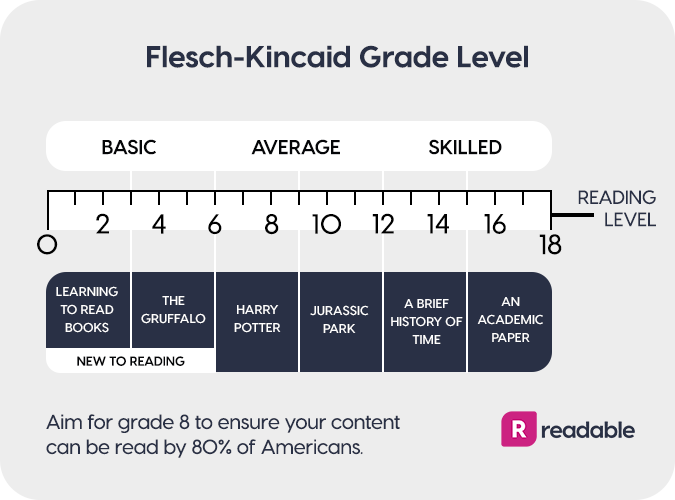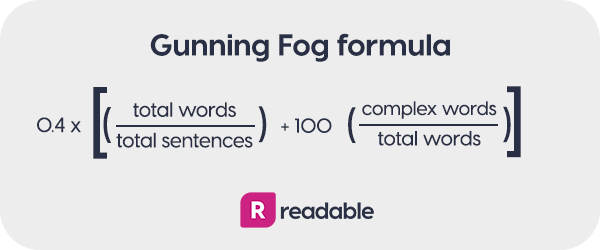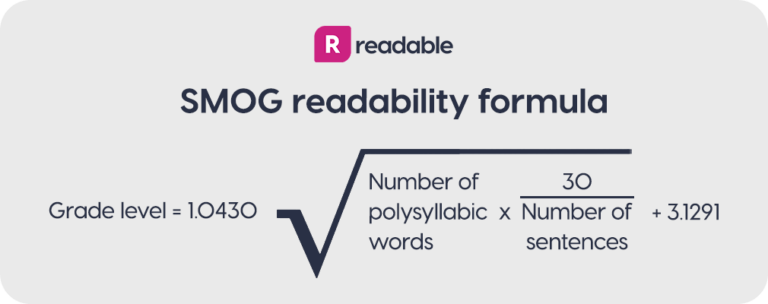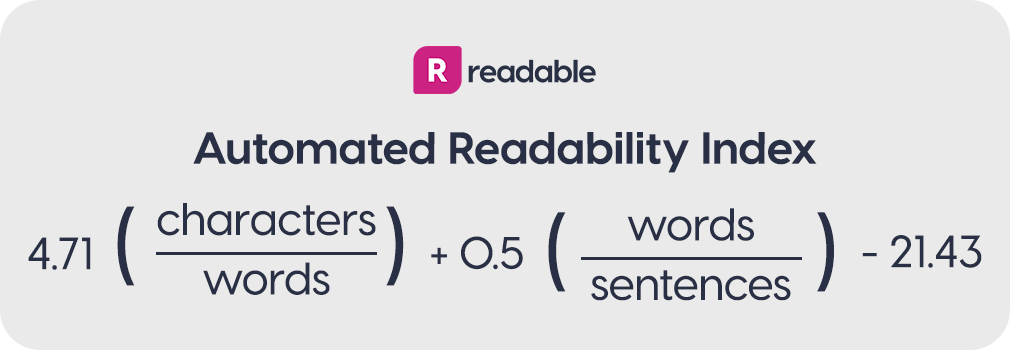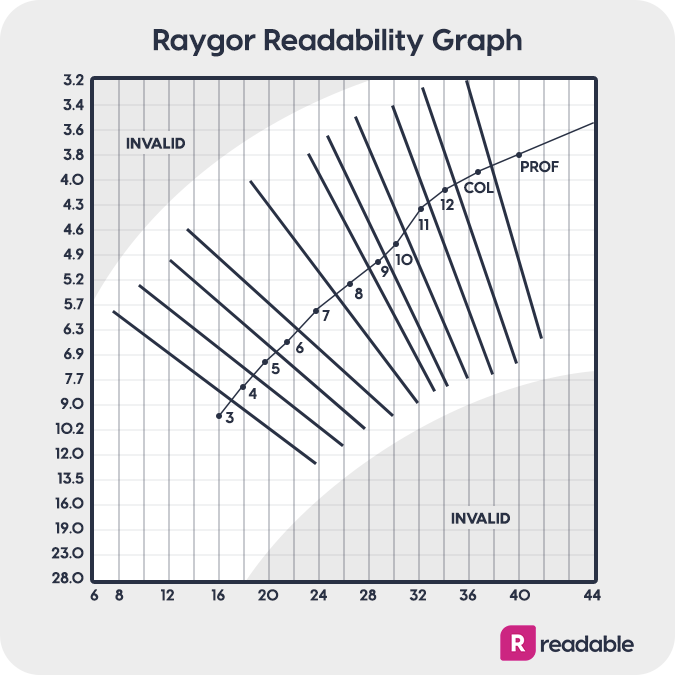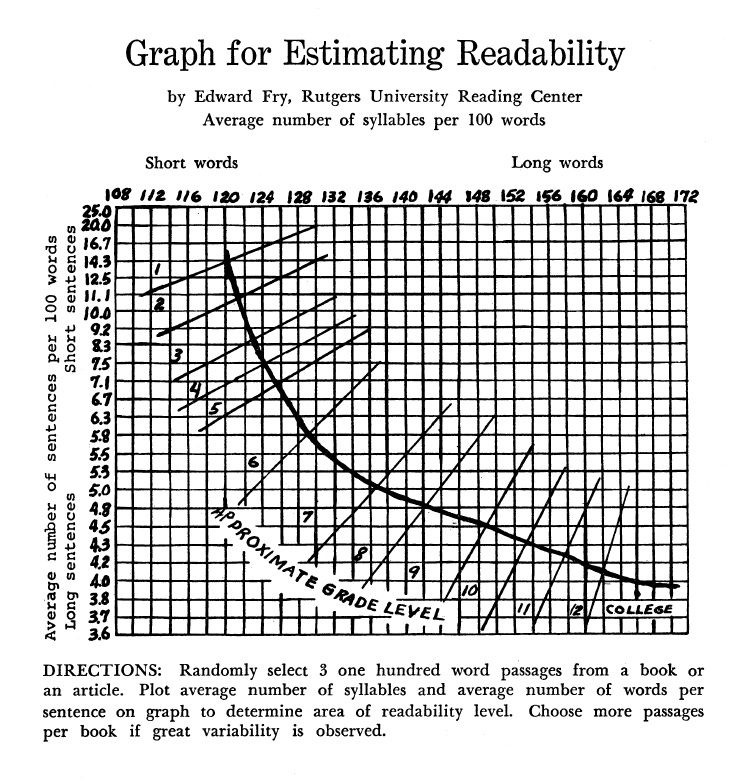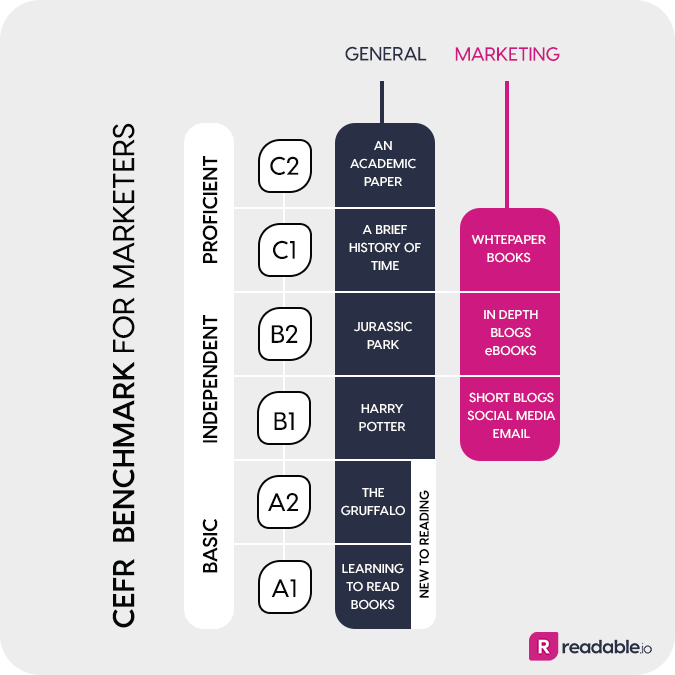Readability formulas
Find out more about the readability formulas that power ReadablePro and which is best for your needs.
Flesch-Kincaid Grade Level
Ideal For: General Usage Created: 1975 Target Score: < 8-10
The Flesch-Kincaid grade level was created by Rudolf Flesch as a way to interpret a US grade level from his Reading Ease formula. He originally created it for the US Navy to analyze their technical material. Since then, it's become a widely respected formula suitable for use with many types of text.
Gunning Fog Index
Ideal For: Business Literature Created: 1952 Target Score: < 8-10
The Gunning Fog Index was created by Robert Gunning, an American businessman. His consultancy, Robert Gunning Associates, aimed to help other businesses with their writing. This formula helps a writer win an audience by clearing unnecessary fog in their text.
Coleman Liau Index
Ideal For: Education Created: 1975 Target Score: < 8-10
The Coleman-Liau Index was created by Meri Coleman and T L Liau. The index doesn't involve syllable counting but instead counted word length in letters. It's widely used and has been used in the medical and translation sectors. It's also useful for the legal sector, where it's been used to explore the readability of judicial opinions.
SMOG Index
Ideal For: Healthcare Created: 1969 Target Score: < 8-10
The SMOG Index was created by G Harry McLaughlin, a clinical psychologist with a passion for simplifying readability formulas. His Simple Measure of Gobbledygook uses polysyllabic words as a variable. SMOG is very useful for medical writing and is considered the 'gold standard' formula in healthcare.
Automated Readability Index
Ideal For: Technical Writing Created: 1967 Target Score: < 8-10
The Automated Readability Index - ARI - was designed for military use. Originally, it was intended for typewriter tabulation. The variables focus on character and word counting and ensured a less laborious calculation method for the time. Now, it's still used widely but is especially useful for technical writing.
FORCAST
Ideal For: Technical Manuals Created: 1973 Target Score: < 8-10
The FORCAST formula was the outcome of a study by HumRRO, which originally developed tools for the US army. FORCAST was developed to improve training documentation for new personnel. It doesn't rely on complete sentences for its analysis, so it's particularly useful for surveys, questionnaires, multiple question tests or any document containing lists or bullet points.
Powers Sumner Kearl
Ideal For: Primary Grades Created: 1958 Target Score: < 8-10
The Powers Sumner Kearl formula was created by R D Powers, W A Sumner and B E Kearl. Similarly to other US grade level formulas, its variables are words, sentence length and syllables. The formula was created in an effort to modernize the comprehension criteria used to test other formulas. It's suited for elementary texts and isn't suited to texts above fourth-grade level.
Rix Readability
Ideal For: Non-English Text Created: 1983 Target Score: < 8-10
Rix was developed by John Aderson, who was inspired by the Lix formula. He considered Lix obscure but impressive and wanted to bring it to light, simplify the process and convert it to a US grade level. He observed an encouraging correlation with other respected readability formulas and validated it using cloze comprehension tests. As this is based on the Lix formula, this too can be used for both English and non-English texts.
Raygor Readability Graph
Ideal For: General Usage Created: 1977 Target Score: < 8-10
The Raygor readability graph was created by Alton L Raygor. He used sentences and letters as variables with a focus on creating a quick and easy formula. It's best used for middle school level texts to separate books into different levels of difficulty.
Fry Readability Graph
Ideal For: Healthcare Created: 1963 Target Score: < 8-10
Edward Fry created the Fry graph with a promise to make a readability formula which had accuracy within a grade level. He also created it with the goal of making the calculation very simple. It can be used for elementary to college level texts. It uses sentences and syllables as variables and is highly regarded today across a wide range of sectors.
Flesch Reading Ease
Ideal For: General Usage Created: 1948 Target Score: > 60
Rudolf Flesch's Reading Ease score was rooted in education research. The formula calculates a score between 1 and 100, with a higher score being more readable. A conversion table was used by teachers to interpret this as a US education grade. The average adult can read a text with a Reading Ease score of 70-80.
CEFR
Ideal For: ESL Students Created: 1989 Target Score: B2
CEFR stands for the Common European Framework of References for Languages. It was originally created for use in schools and workplaces as an analysis of language skills. Since then, it's also been used by governments to ensure their content is reaching a wide audience. Aim for around a B2 grade which indicates a competent language user.
IELTS
Ideal For: ESL Students Created: 1980 Target Score: < 6
IELTS stands for the International English Language Testing System. It's one of the largest English language tests in the world and is trusted by key authorities to assess the level of proficiency in the English language. It can now be used to make your content inclusive and accessible. Aim for around a grade 6 to ensure a competent English language user can understand your text.
Spache Readability Formula
Ideal For: Primary Grades Created: 1952 Target Score: < 4
Created by George Spache, the Spache score was created for use in elementary schools. Spache made a list of everyday words which a child up to fourth grade can usually understand. The text used for analysis is then compared to this word list and the more unfamiliar words, the harder the text is for a young child. Sentence length is also taken into account.
Dale-Chall Readability Formula
Ideal For: Student Materials Created: 1995 Target Score: < 8-10
The New Dale-Chall word list was created by Edgard Dale and Jeanne Chall. Whereas formulas such as Spache and Powers Sumner Kearl are designed for students up to fourth grade, New Dale-Chall was created for use by fourth-grade students or higher within elementary school. Being a word list formula, the more unfamiliar words that appear in the text, the more difficult the text will be for a fourth-grader.
Lix Readability
Ideal For: Non-English Text Created: 1968 Target Score: < 40
The Lix readability formula was created by Carl-Hugo Björnsson in Sweden. Although a relatively obscure formula compared to the more well-known calculations, it was extensively trialed and is reliable for use from elementary to adult level. It's also suitable for use with both English and non-English texts. Aim for a score between 35-45 for your text to be easily understood by the average person.
Lensear Write
Ideal For: Technical Writing Created: 1966 Target Score: 70 - 80
The Linsear-Write calculation was originally created by John O'Hayre, an employee of the Bureau of Land Management in Denver, Colorado. He detailed the formula as a solution to what he called stuffy 'governmentese' or 'officialese'. With an emphasis on writeability, it can help you to write actively and directly. For the average adult reader, aim for a score between 70 and 80.
Are you engaging your audience with readable content?
All ReadablePro plans include
Score Text
Score URLs
Score Documents
Score Emails
Generate Reports
Multiple Users
Keyword Density
Quality Control
for Content
Secure Data
Cancel Anytime
Industry-leading
Algorithms
Cutting-Edge
Accuracy
3,000+ authors, marketers, and educators trust us to deliver accurate readability analysis.









